University Calculus Assignment: Multiple Integrals and Curvature
VerifiedAdded on 2022/08/26
|10
|380
|25
Homework Assignment
AI Summary
This assignment presents solutions to problems on multiple integrals and curvature, covering topics such as Jacobian transformations, polar coordinates, and the calculation of arc length and radius of curvature. It includes detailed step-by-step solutions for various problems, including those involving the evaluation of integrals, determination of the area and volume, and analysis of curves such as the cycloid and Cornu spiral. The assignment provides a comprehensive understanding of the concepts and techniques involved in solving these types of problems, with the goal of helping students improve their calculus skills. The solutions are provided with clear explanations and formulas, offering a valuable resource for students studying calculus and related fields.
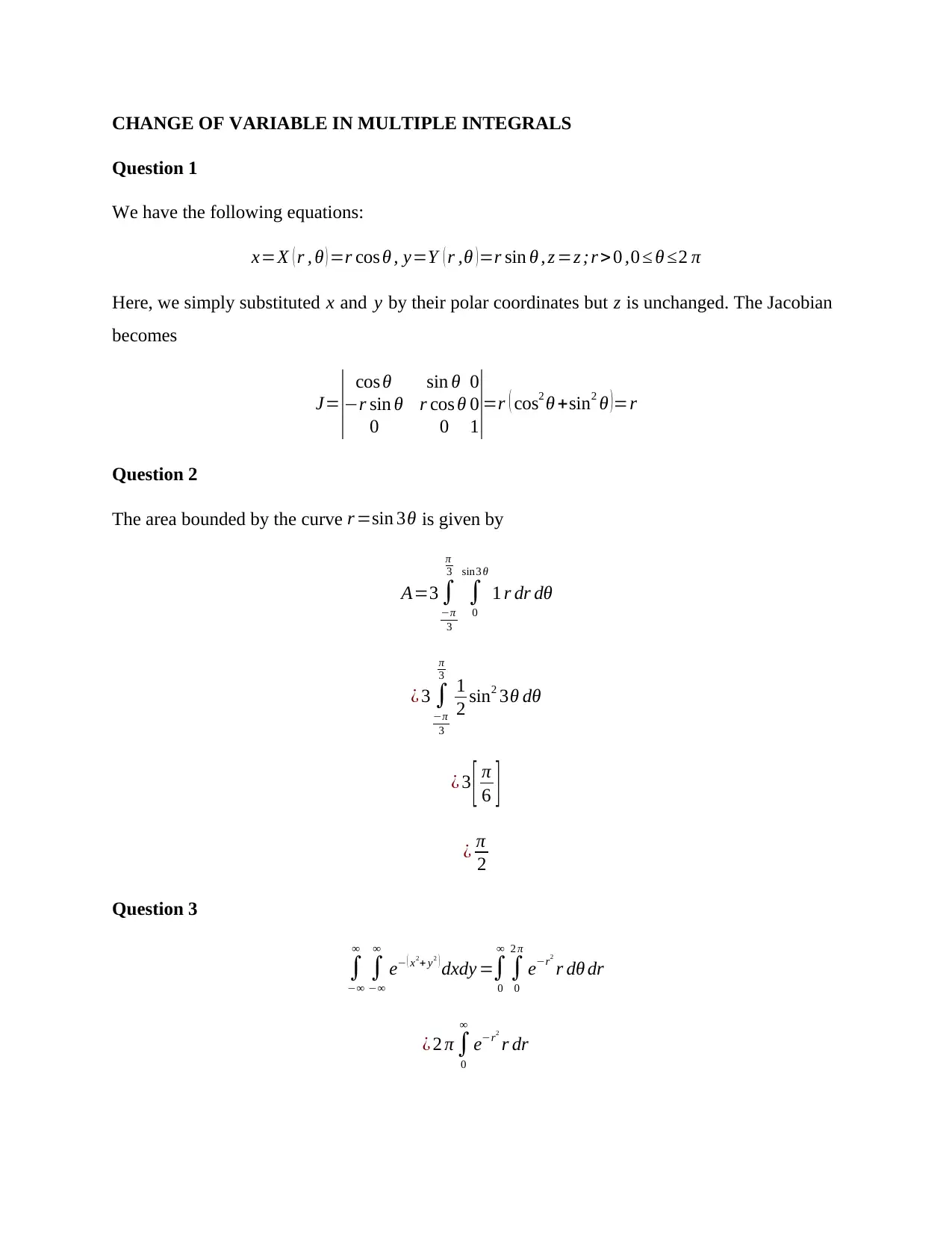
CHANGE OF VARIABLE IN MULTIPLE INTEGRALS
Question 1
We have the following equations:
x=X ( r , θ ) =r cos θ , y=Y ( r ,θ ) =r sin θ , z =z ;r > 0 ,0 ≤ θ ≤2 π
Here, we simply substituted x and y by their polar coordinates but z is unchanged. The Jacobian
becomes
J=
| cos θ sin θ
−r sin θ
0
r cos θ
0
0
0
1|=r ( cos2 θ +sin2 θ )=r
Question 2
The area bounded by the curve r =sin 3θ is given by
A=3 ∫
−π
3
π
3
∫
0
sin3 θ
1 r dr dθ
¿ 3 ∫
−π
3
π
3
1
2 sin2 3θ dθ
¿ 3 [ π
6 ]
¿ π
2
Question 3
∫
−∞
∞
∫
−∞
∞
e− ( x2+ y2 ) dxdy =∫
0
∞
∫
0
2 π
e−r2
r dθ dr
¿ 2 π ∫
0
∞
e−r2
r dr
Question 1
We have the following equations:
x=X ( r , θ ) =r cos θ , y=Y ( r ,θ ) =r sin θ , z =z ;r > 0 ,0 ≤ θ ≤2 π
Here, we simply substituted x and y by their polar coordinates but z is unchanged. The Jacobian
becomes
J=
| cos θ sin θ
−r sin θ
0
r cos θ
0
0
0
1|=r ( cos2 θ +sin2 θ )=r
Question 2
The area bounded by the curve r =sin 3θ is given by
A=3 ∫
−π
3
π
3
∫
0
sin3 θ
1 r dr dθ
¿ 3 ∫
−π
3
π
3
1
2 sin2 3θ dθ
¿ 3 [ π
6 ]
¿ π
2
Question 3
∫
−∞
∞
∫
−∞
∞
e− ( x2+ y2 ) dxdy =∫
0
∞
∫
0
2 π
e−r2
r dθ dr
¿ 2 π ∫
0
∞
e−r2
r dr
Paraphrase This Document
Need a fresh take? Get an instant paraphrase of this document with our AI Paraphraser
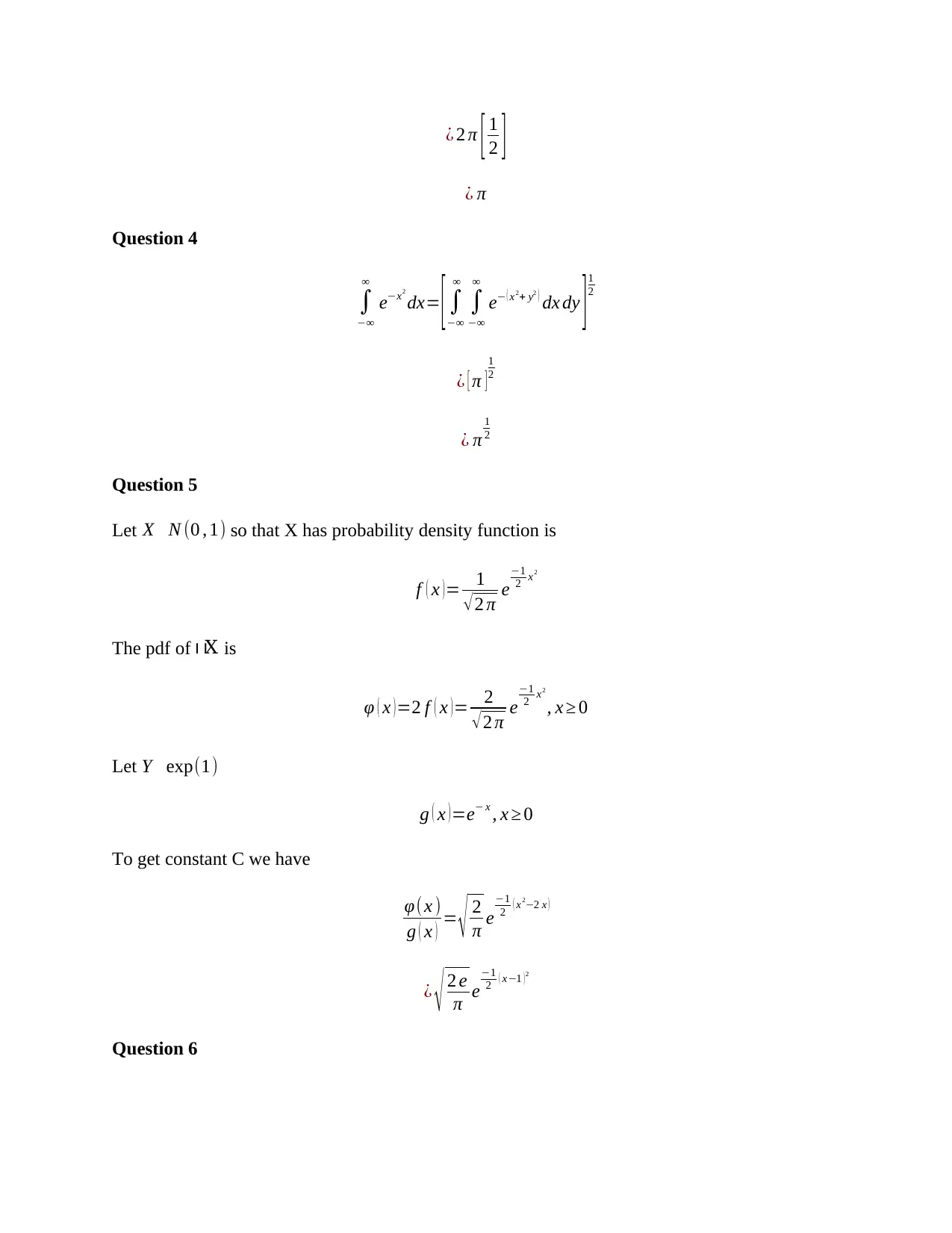
¿ 2 π [ 1
2 ]
¿ π
Question 4
∫
−∞
∞
e−x2
dx= [∫
−∞
∞
∫
−∞
∞
e− ( x2+ y2 ) dx dy ]1
2
¿ [ π ]
1
2
¿ π
1
2
Question 5
Let X N (0 , 1) so that X has probability density function is
f ( x )= 1
√2 π e
−1
2 x2
The pdf of ⃓ X⃓ is
φ ( x ) =2 f ( x ) = 2
√ 2 π e
−1
2 x2
, x ≥ 0
Let Y exp(1)
g ( x )=e− x , x ≥ 0
To get constant C we have
φ(x )
g ( x ) = √ 2
π e
−1
2 ( x2−2 x )
¿ √ 2 e
π e
−1
2 ( x−1 ) 2
Question 6
2 ]
¿ π
Question 4
∫
−∞
∞
e−x2
dx= [∫
−∞
∞
∫
−∞
∞
e− ( x2+ y2 ) dx dy ]1
2
¿ [ π ]
1
2
¿ π
1
2
Question 5
Let X N (0 , 1) so that X has probability density function is
f ( x )= 1
√2 π e
−1
2 x2
The pdf of ⃓ X⃓ is
φ ( x ) =2 f ( x ) = 2
√ 2 π e
−1
2 x2
, x ≥ 0
Let Y exp(1)
g ( x )=e− x , x ≥ 0
To get constant C we have
φ(x )
g ( x ) = √ 2
π e
−1
2 ( x2−2 x )
¿ √ 2 e
π e
−1
2 ( x−1 ) 2
Question 6
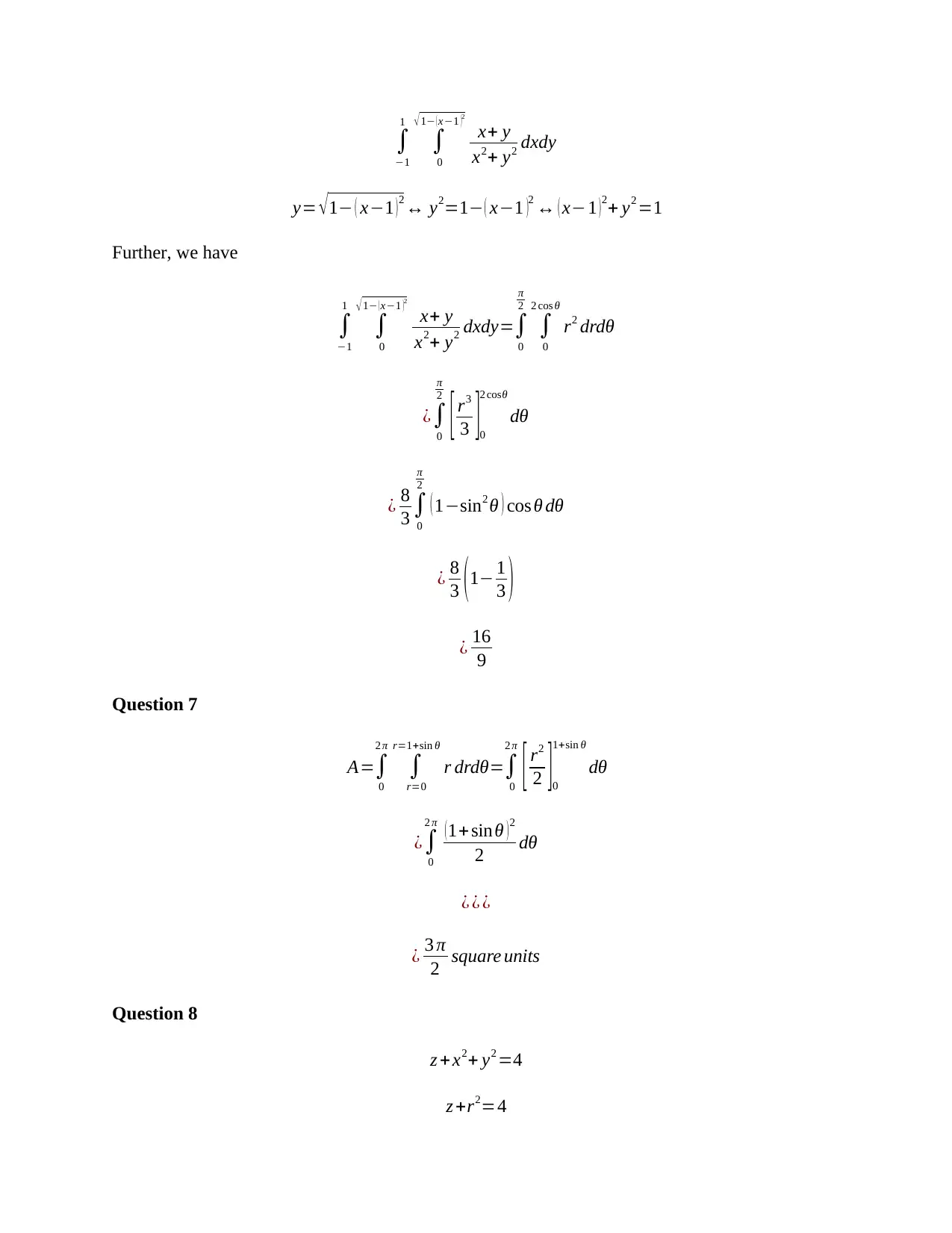
∫
−1
1
∫
0
√ 1− ( x−1 )
2
x+ y
x2+ y2 dxdy
y= √1− ( x−1 )2 ↔ y2=1− ( x−1 )2 ↔ ( x−1 )2+ y2 =1
Further, we have
∫
−1
1
∫
0
√ 1− ( x−1 )2
x+ y
x2+ y2 dxdy=∫
0
π
2
∫
0
2 cos θ
r2 drdθ
¿∫
0
π
2
[ r3
3 ]0
2 cosθ
dθ
¿ 8
3 ∫
0
π
2
( 1−sin2 θ ) cos θ dθ
¿ 8
3 ( 1− 1
3 )
¿ 16
9
Question 7
A=∫
0
2 π
∫
r=0
r=1+sin θ
r drdθ=∫
0
2 π
[ r2
2 ]0
1+sin θ
dθ
¿∫
0
2 π ( 1+ sin θ ) 2
2 dθ
¿ ¿ ¿
¿ 3 π
2 square units
Question 8
z +x2+ y2 =4
z +r2=4
−1
1
∫
0
√ 1− ( x−1 )
2
x+ y
x2+ y2 dxdy
y= √1− ( x−1 )2 ↔ y2=1− ( x−1 )2 ↔ ( x−1 )2+ y2 =1
Further, we have
∫
−1
1
∫
0
√ 1− ( x−1 )2
x+ y
x2+ y2 dxdy=∫
0
π
2
∫
0
2 cos θ
r2 drdθ
¿∫
0
π
2
[ r3
3 ]0
2 cosθ
dθ
¿ 8
3 ∫
0
π
2
( 1−sin2 θ ) cos θ dθ
¿ 8
3 ( 1− 1
3 )
¿ 16
9
Question 7
A=∫
0
2 π
∫
r=0
r=1+sin θ
r drdθ=∫
0
2 π
[ r2
2 ]0
1+sin θ
dθ
¿∫
0
2 π ( 1+ sin θ ) 2
2 dθ
¿ ¿ ¿
¿ 3 π
2 square units
Question 8
z +x2+ y2 =4
z +r2=4
⊘ This is a preview!⊘
Do you want full access?
Subscribe today to unlock all pages.

Trusted by 1+ million students worldwide
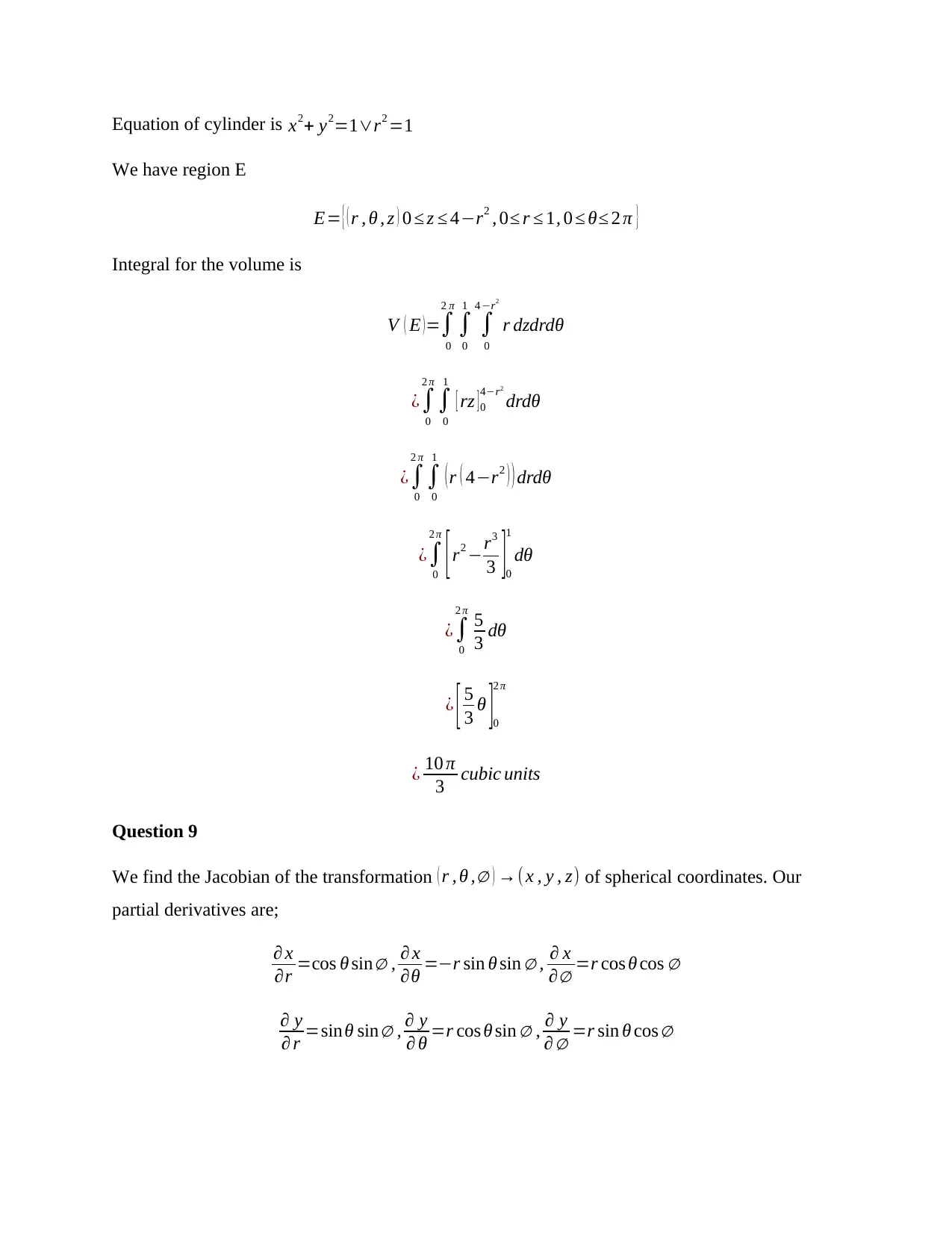
Equation of cylinder is x2+ y2=1∨r2 =1
We have region E
E= { ( r , θ , z ) 0 ≤ z ≤ 4−r2 , 0≤ r ≤ 1, 0 ≤ θ≤ 2 π }
Integral for the volume is
V ( E ) =∫
0
2 π
∫
0
1
∫
0
4 −r2
r dzdrdθ
¿∫
0
2 π
∫
0
1
[ rz ] 0
4−r2
drdθ
¿∫
0
2 π
∫
0
1
(r ( 4−r2 ) ) drdθ
¿∫
0
2 π
[r2 −r3
3 ]0
1
dθ
¿∫
0
2 π
5
3 dθ
¿ [ 5
3 θ ]0
2 π
¿ 10 π
3 cubic units
Question 9
We find the Jacobian of the transformation ( r , θ ,∅ ) →(x , y , z) of spherical coordinates. Our
partial derivatives are;
∂ x
∂r =cos θ sin∅ , ∂ x
∂θ =−r sin θ sin ∅ , ∂ x
∂∅ =r cos θ cos ∅
∂ y
∂ r =sinθ sin∅ , ∂ y
∂ θ =r cos θ sin ∅ , ∂ y
∂ ∅ =r sin θ cos ∅
We have region E
E= { ( r , θ , z ) 0 ≤ z ≤ 4−r2 , 0≤ r ≤ 1, 0 ≤ θ≤ 2 π }
Integral for the volume is
V ( E ) =∫
0
2 π
∫
0
1
∫
0
4 −r2
r dzdrdθ
¿∫
0
2 π
∫
0
1
[ rz ] 0
4−r2
drdθ
¿∫
0
2 π
∫
0
1
(r ( 4−r2 ) ) drdθ
¿∫
0
2 π
[r2 −r3
3 ]0
1
dθ
¿∫
0
2 π
5
3 dθ
¿ [ 5
3 θ ]0
2 π
¿ 10 π
3 cubic units
Question 9
We find the Jacobian of the transformation ( r , θ ,∅ ) →(x , y , z) of spherical coordinates. Our
partial derivatives are;
∂ x
∂r =cos θ sin∅ , ∂ x
∂θ =−r sin θ sin ∅ , ∂ x
∂∅ =r cos θ cos ∅
∂ y
∂ r =sinθ sin∅ , ∂ y
∂ θ =r cos θ sin ∅ , ∂ y
∂ ∅ =r sin θ cos ∅
Paraphrase This Document
Need a fresh take? Get an instant paraphrase of this document with our AI Paraphraser
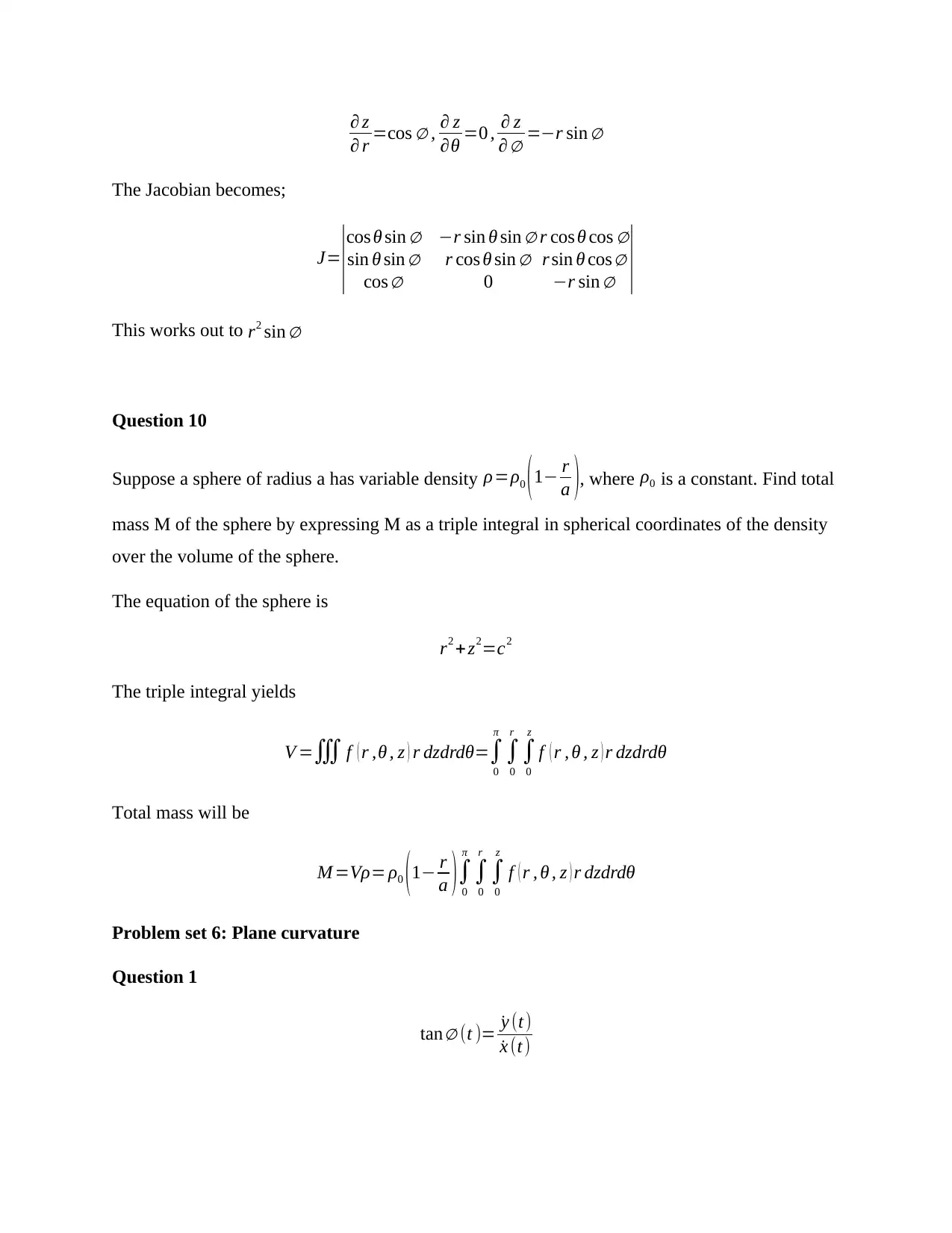
∂ z
∂ r =cos ∅ , ∂ z
∂θ =0 , ∂ z
∂ ∅ =−r sin ∅
The Jacobian becomes;
J=
|
cos θ sin ∅ −r sin θ sin ∅
sin θ sin ∅
cos ∅
r cos θ sin ∅
0
r cos θ cos ∅
r sin θ cos ∅
−r sin ∅ |
This works out to r2 sin ∅
Question 10
Suppose a sphere of radius a has variable density ρ=ρ0 (1− r
a ), where ρ0 is a constant. Find total
mass M of the sphere by expressing M as a triple integral in spherical coordinates of the density
over the volume of the sphere.
The equation of the sphere is
r2 + z2=c2
The triple integral yields
V =∭ f ( r ,θ , z ) r dzdrdθ=∫
0
π
∫
0
r
∫
0
z
f ( r , θ , z ) r dzdrdθ
Total mass will be
M =Vρ= ρ0 (1− r
a )∫
0
π
∫
0
r
∫
0
z
f ( r , θ , z ) r dzdrdθ
Problem set 6: Plane curvature
Question 1
tan∅ (t )= ˙y (t)
˙x (t)
∂ r =cos ∅ , ∂ z
∂θ =0 , ∂ z
∂ ∅ =−r sin ∅
The Jacobian becomes;
J=
|
cos θ sin ∅ −r sin θ sin ∅
sin θ sin ∅
cos ∅
r cos θ sin ∅
0
r cos θ cos ∅
r sin θ cos ∅
−r sin ∅ |
This works out to r2 sin ∅
Question 10
Suppose a sphere of radius a has variable density ρ=ρ0 (1− r
a ), where ρ0 is a constant. Find total
mass M of the sphere by expressing M as a triple integral in spherical coordinates of the density
over the volume of the sphere.
The equation of the sphere is
r2 + z2=c2
The triple integral yields
V =∭ f ( r ,θ , z ) r dzdrdθ=∫
0
π
∫
0
r
∫
0
z
f ( r , θ , z ) r dzdrdθ
Total mass will be
M =Vρ= ρ0 (1− r
a )∫
0
π
∫
0
r
∫
0
z
f ( r , θ , z ) r dzdrdθ
Problem set 6: Plane curvature
Question 1
tan∅ (t )= ˙y (t)
˙x (t)
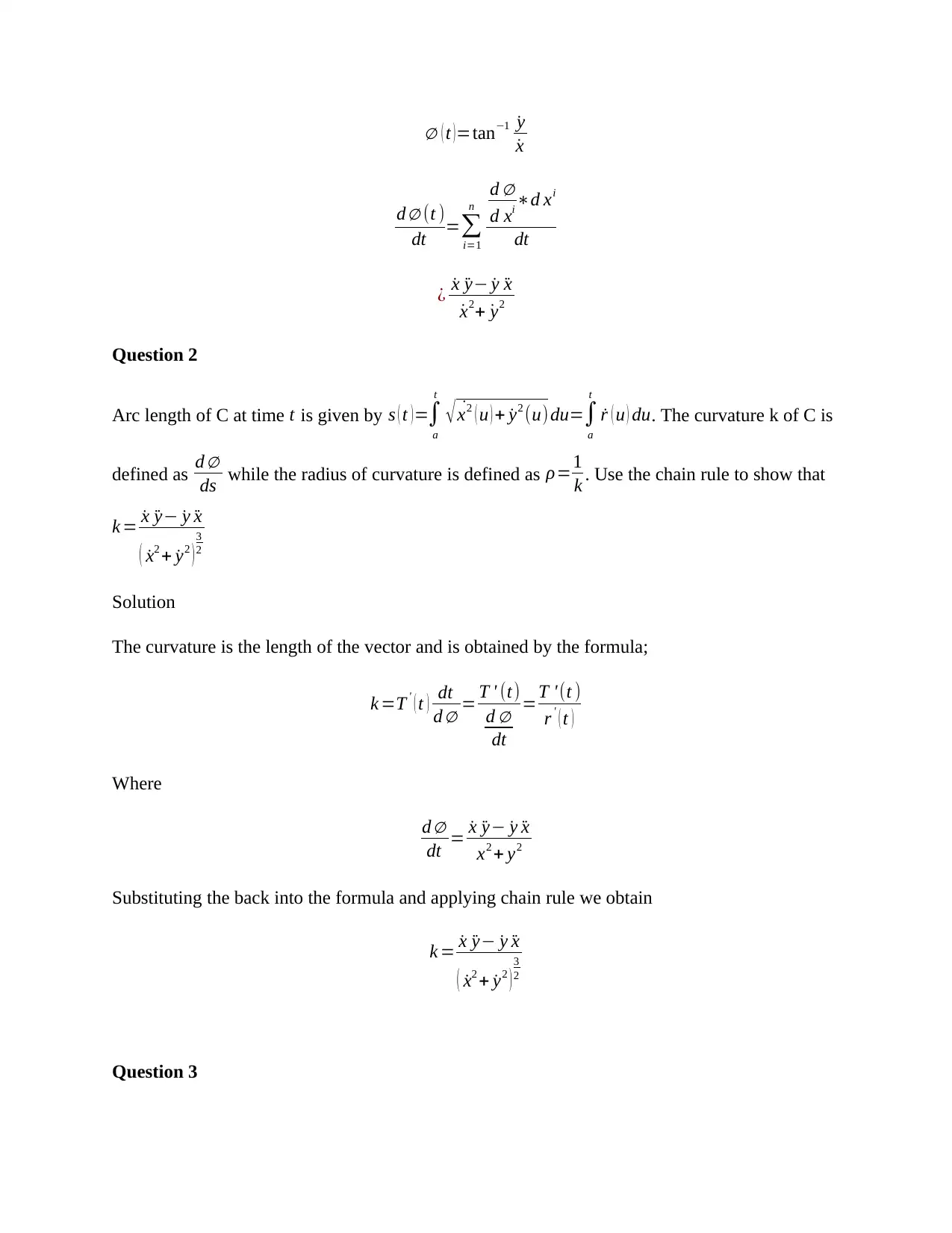
∅ ( t )=tan−1 ˙y
˙x
d ∅ (t )
dt =∑
i=1
n
d ∅
d xi ∗d xi
dt
¿ ˙x ¨y− ˙y ¨x
˙x2+ ˙y2
Question 2
Arc length of C at time t is given by s ( t ) =∫
a
t
√ ˙x2 ( u ) + ˙y2 (u)du=∫
a
t
˙r ( u ) du. The curvature k of C is
defined as d ∅
ds while the radius of curvature is defined as ρ=1
k . Use the chain rule to show that
k = ˙x ¨y− ˙y ¨x
( ˙x2 + ˙y2 )
3
2
Solution
The curvature is the length of the vector and is obtained by the formula;
k =T ' ( t ) dt
d ∅ = T ' (t)
d ∅
dt
=T '(t )
r ' ( t )
Where
d ∅
dt = ˙x ¨y− ˙y ¨x
x2 + y2
Substituting the back into the formula and applying chain rule we obtain
k = ˙x ¨y− ˙y ¨x
( ˙x2 + ˙y2 )
3
2
Question 3
˙x
d ∅ (t )
dt =∑
i=1
n
d ∅
d xi ∗d xi
dt
¿ ˙x ¨y− ˙y ¨x
˙x2+ ˙y2
Question 2
Arc length of C at time t is given by s ( t ) =∫
a
t
√ ˙x2 ( u ) + ˙y2 (u)du=∫
a
t
˙r ( u ) du. The curvature k of C is
defined as d ∅
ds while the radius of curvature is defined as ρ=1
k . Use the chain rule to show that
k = ˙x ¨y− ˙y ¨x
( ˙x2 + ˙y2 )
3
2
Solution
The curvature is the length of the vector and is obtained by the formula;
k =T ' ( t ) dt
d ∅ = T ' (t)
d ∅
dt
=T '(t )
r ' ( t )
Where
d ∅
dt = ˙x ¨y− ˙y ¨x
x2 + y2
Substituting the back into the formula and applying chain rule we obtain
k = ˙x ¨y− ˙y ¨x
( ˙x2 + ˙y2 )
3
2
Question 3
⊘ This is a preview!⊘
Do you want full access?
Subscribe today to unlock all pages.

Trusted by 1+ million students worldwide
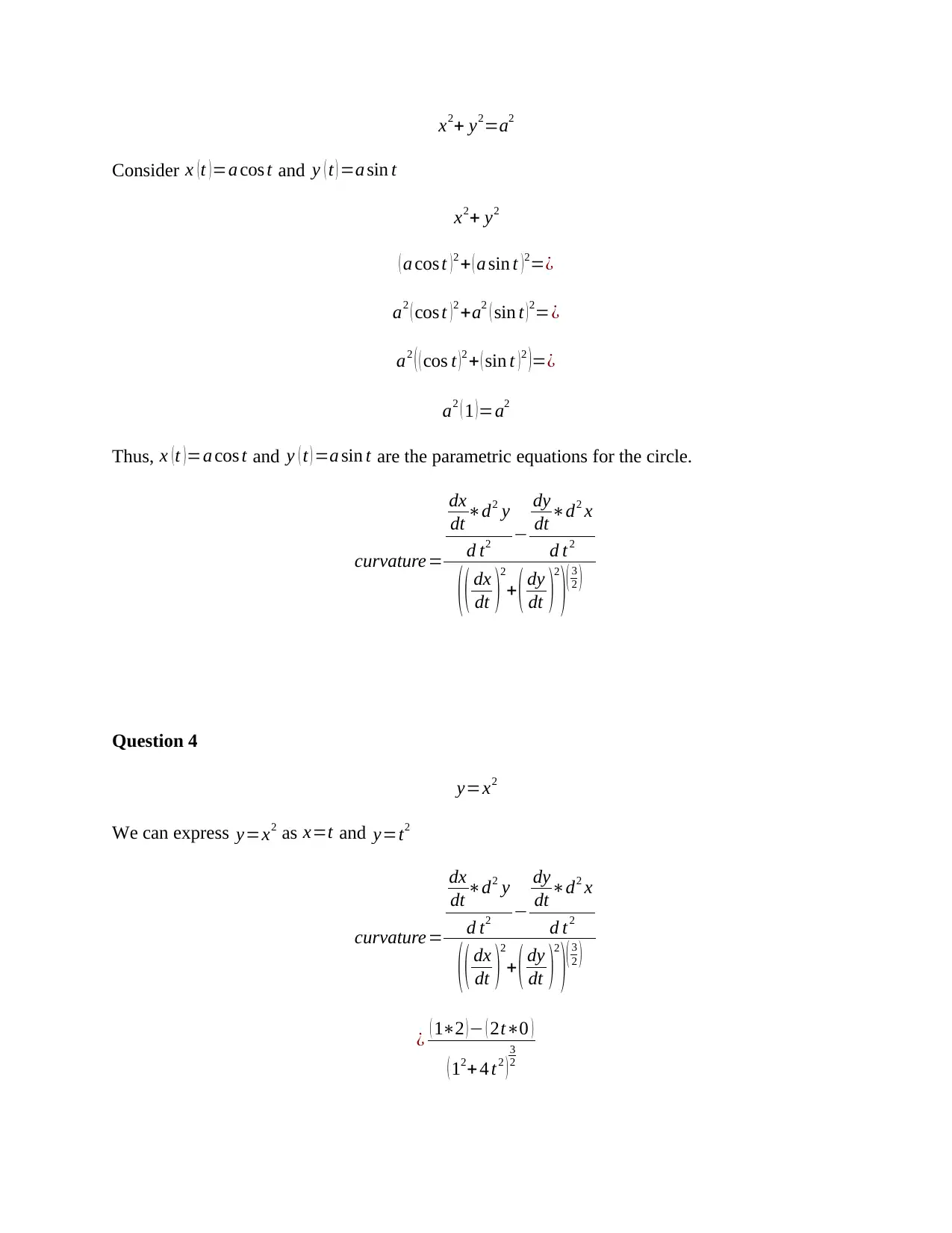
x2+ y2=a2
Consider x ( t ) =a cos t and y ( t ) =a sin t
x2+ y2
( a cos t ) 2 + ( a sin t ) 2=¿
a2 ( cos t )2 +a2 ( sin t )2=¿
a2 ( ( cos t )2 + ( sin t )2 )=¿
a2 ( 1 )=a2
Thus, x (t )=a cos t and y ( t ) =a sin t are the parametric equations for the circle.
curvature=
dx
dt ∗d2 y
d t2 −
dy
dt ∗d2 x
d t2
( ( dx
dt )2
+ ( dy
dt )2
)( 3
2 )
Question 4
y=x2
We can express y=x2 as x=t and y=t2
curvature=
dx
dt ∗d2 y
d t2 −
dy
dt ∗d2 x
d t2
( ( dx
dt )2
+ ( dy
dt )2
)( 3
2 )
¿ ( 1∗2 ) − ( 2t∗0 )
( 12+ 4 t2 )
3
2
Consider x ( t ) =a cos t and y ( t ) =a sin t
x2+ y2
( a cos t ) 2 + ( a sin t ) 2=¿
a2 ( cos t )2 +a2 ( sin t )2=¿
a2 ( ( cos t )2 + ( sin t )2 )=¿
a2 ( 1 )=a2
Thus, x (t )=a cos t and y ( t ) =a sin t are the parametric equations for the circle.
curvature=
dx
dt ∗d2 y
d t2 −
dy
dt ∗d2 x
d t2
( ( dx
dt )2
+ ( dy
dt )2
)( 3
2 )
Question 4
y=x2
We can express y=x2 as x=t and y=t2
curvature=
dx
dt ∗d2 y
d t2 −
dy
dt ∗d2 x
d t2
( ( dx
dt )2
+ ( dy
dt )2
)( 3
2 )
¿ ( 1∗2 ) − ( 2t∗0 )
( 12+ 4 t2 )
3
2
Paraphrase This Document
Need a fresh take? Get an instant paraphrase of this document with our AI Paraphraser
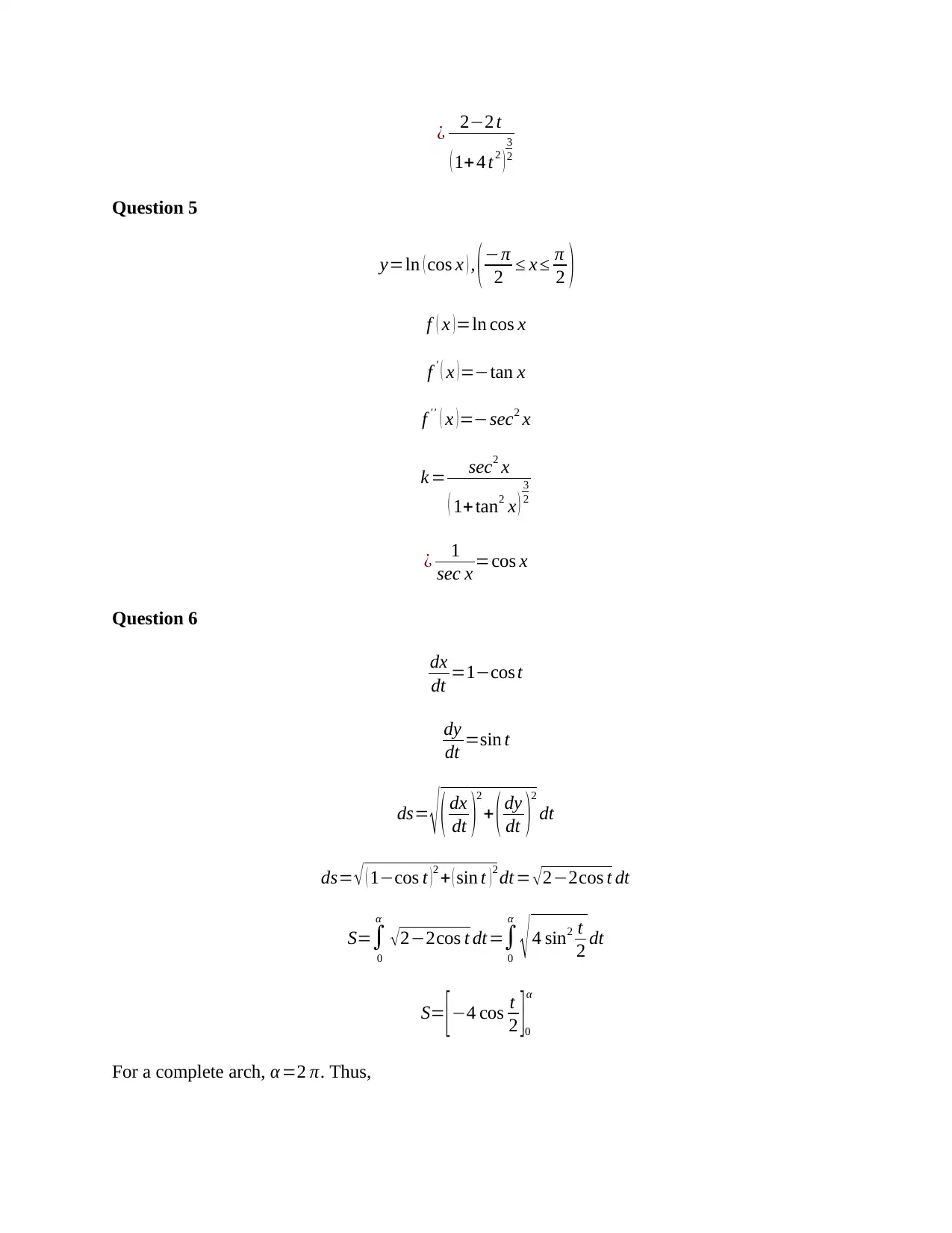
¿ 2−2 t
( 1+ 4 t2 )
3
2
Question 5
y=ln ( cos x ) , (−π
2 ≤ x ≤ π
2 )
f ( x )=ln cos x
f ' ( x )=−tan x
f ' ' ( x ) =−sec2 x
k = sec2 x
( 1+ tan2 x )
3
2
¿ 1
sec x =cos x
Question 6
dx
dt =1−cos t
dy
dt =sin t
ds= √ ( dx
dt )2
+ ( dy
dt )2
dt
ds= √ ( 1−cos t ) 2 + ( sin t ) 2 dt = √ 2−2cos t dt
S=∫
0
α
√2−2cos t dt=∫
0
α
√ 4 sin2 t
2 dt
S= [−4 cos t
2 ]0
α
For a complete arch, α =2 π. Thus,
( 1+ 4 t2 )
3
2
Question 5
y=ln ( cos x ) , (−π
2 ≤ x ≤ π
2 )
f ( x )=ln cos x
f ' ( x )=−tan x
f ' ' ( x ) =−sec2 x
k = sec2 x
( 1+ tan2 x )
3
2
¿ 1
sec x =cos x
Question 6
dx
dt =1−cos t
dy
dt =sin t
ds= √ ( dx
dt )2
+ ( dy
dt )2
dt
ds= √ ( 1−cos t ) 2 + ( sin t ) 2 dt = √ 2−2cos t dt
S=∫
0
α
√2−2cos t dt=∫
0
α
√ 4 sin2 t
2 dt
S= [−4 cos t
2 ]0
α
For a complete arch, α =2 π. Thus,
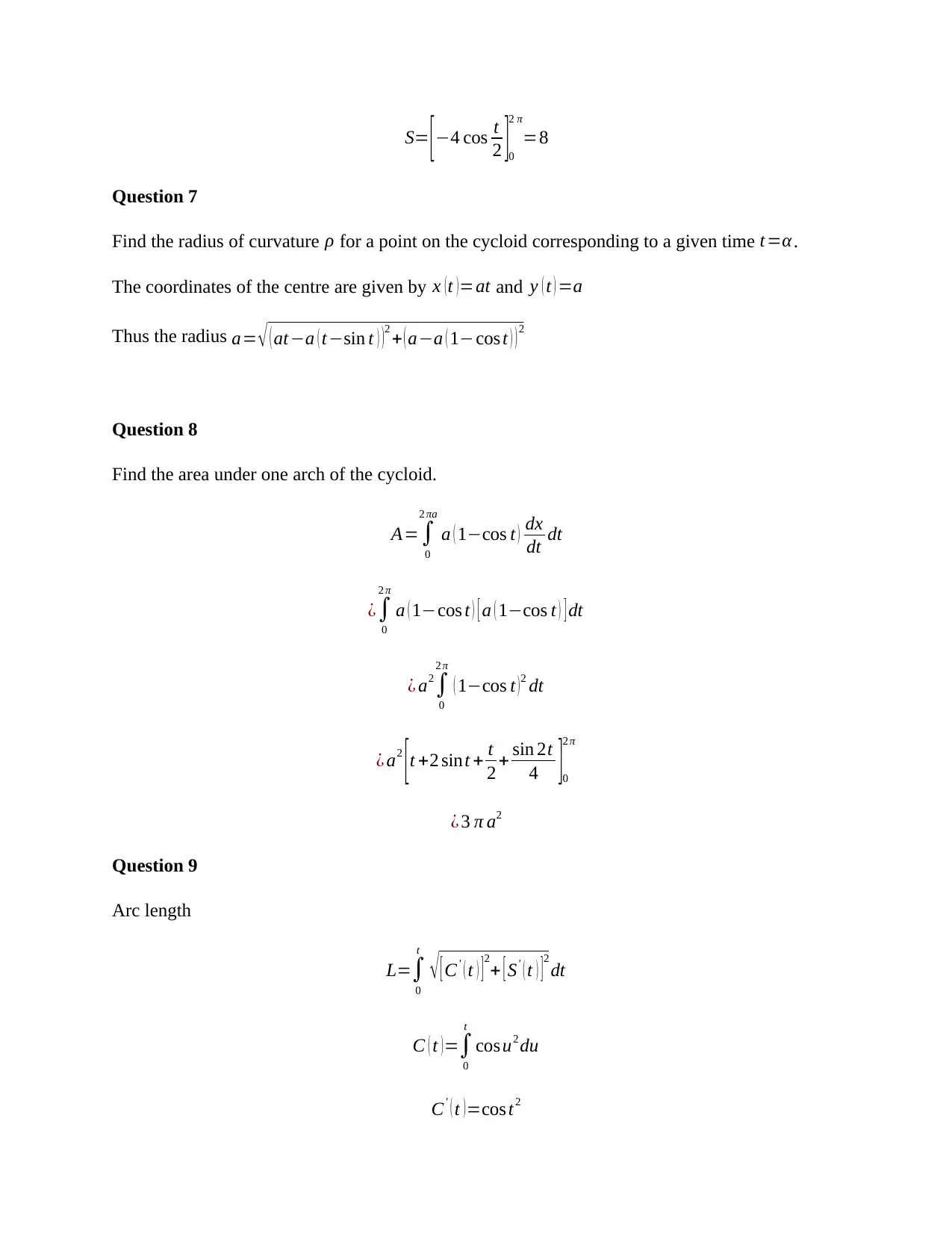
S= [−4 cos t
2 ]0
2 π
=8
Question 7
Find the radius of curvature ρ for a point on the cycloid corresponding to a given time t=α .
The coordinates of the centre are given by x (t )=at and y ( t ) =a
Thus the radius a= √ ( at−a ( t−sin t ) )
2
+ ( a−a ( 1−cos t ) ) 2
Question 8
Find the area under one arch of the cycloid.
A=∫
0
2 πa
a ( 1−cos t ) dx
dt dt
¿∫
0
2 π
a ( 1−cos t ) [ a ( 1−cos t ) ] dt
¿ a2
∫
0
2 π
( 1−cos t )2 dt
¿ a2
[t +2 sint + t
2 + sin 2t
4 ]0
2 π
¿ 3 π a2
Question 9
Arc length
L=∫
0
t
√ [ C' ( t ) ] 2
+ [ S' ( t ) ] 2
dt
C ( t ) =∫
0
t
cos u2 du
C' ( t )=cos t2
2 ]0
2 π
=8
Question 7
Find the radius of curvature ρ for a point on the cycloid corresponding to a given time t=α .
The coordinates of the centre are given by x (t )=at and y ( t ) =a
Thus the radius a= √ ( at−a ( t−sin t ) )
2
+ ( a−a ( 1−cos t ) ) 2
Question 8
Find the area under one arch of the cycloid.
A=∫
0
2 πa
a ( 1−cos t ) dx
dt dt
¿∫
0
2 π
a ( 1−cos t ) [ a ( 1−cos t ) ] dt
¿ a2
∫
0
2 π
( 1−cos t )2 dt
¿ a2
[t +2 sint + t
2 + sin 2t
4 ]0
2 π
¿ 3 π a2
Question 9
Arc length
L=∫
0
t
√ [ C' ( t ) ] 2
+ [ S' ( t ) ] 2
dt
C ( t ) =∫
0
t
cos u2 du
C' ( t )=cos t2
⊘ This is a preview!⊘
Do you want full access?
Subscribe today to unlock all pages.

Trusted by 1+ million students worldwide
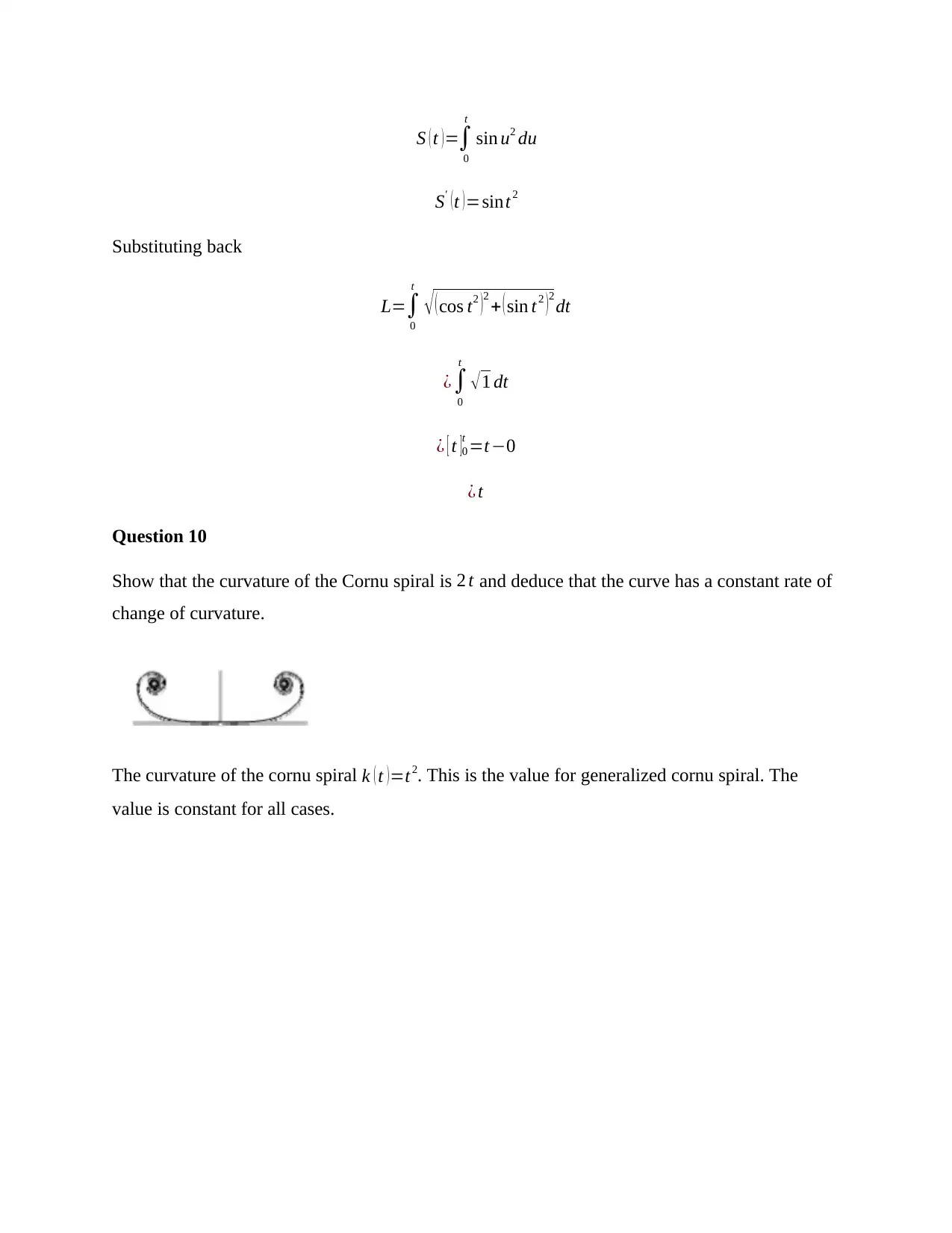
S ( t ) =∫
0
t
sin u2 du
S' (t )=sint2
Substituting back
L=∫
0
t
√ (cos t2 )2
+ ( sin t2 )2
dt
¿∫
0
t
√ 1 dt
¿ [ t ]0
t =t −0
¿ t
Question 10
Show that the curvature of the Cornu spiral is 2 t and deduce that the curve has a constant rate of
change of curvature.
The curvature of the cornu spiral k ( t )=t2. This is the value for generalized cornu spiral. The
value is constant for all cases.
0
t
sin u2 du
S' (t )=sint2
Substituting back
L=∫
0
t
√ (cos t2 )2
+ ( sin t2 )2
dt
¿∫
0
t
√ 1 dt
¿ [ t ]0
t =t −0
¿ t
Question 10
Show that the curvature of the Cornu spiral is 2 t and deduce that the curve has a constant rate of
change of curvature.
The curvature of the cornu spiral k ( t )=t2. This is the value for generalized cornu spiral. The
value is constant for all cases.
1 out of 10
Your All-in-One AI-Powered Toolkit for Academic Success.
+13062052269
info@desklib.com
Available 24*7 on WhatsApp / Email
![[object Object]](/_next/static/media/star-bottom.7253800d.svg)
Unlock your academic potential
Copyright © 2020–2025 A2Z Services. All Rights Reserved. Developed and managed by ZUCOL.

